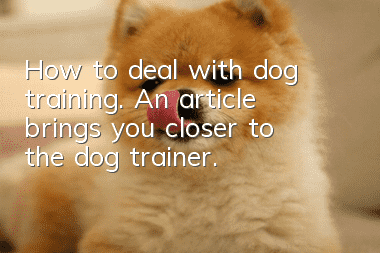How to deal with dog training. An article brings you closer to the dog trainer.

The number of snacks given is the key
In fact, the basic theory of dog training is very simple and everyone can understand it, but why is there such a big difference in operation?
The most common mistake many people make when training their dogs is that they give the wrong number of treats in order to get their dogs to perform better.
Reward-based training is widely considered the most successful method of teaching commands to dogs, but a significant number of pet parents inadvertently sabotage their pets by failing to use effective methods, according to dog training magazine Bark improvement.
If there are two extremes in reward training methods, then on one end are those situations where a dog is given a treat every time it responds; on the other end are those situations where no reward is given at all.
Both situations may result in lower command compliance, resulting in poor training.
If you find that your dog only responds to your commands, or to commands like "sit," then you are probably giving him too many rewards.
Many dogs in this situation learn two things, either follow the rules and insist on sitting still and you will get a treat, or they can ignore the scavenger.
When teaching new commands, continuous reinforcement (CR) is necessary so that the dog learns to establish the connection. However, if you continue giving treats for too long, he may stop trying.
CR for too long can also cause a dog to become dependent on food rewards: it will refuse to work unless food is given away.
You need to change the rules of the game so that the dog does not know when he will get the reward.
Why are some claw machines and gambling machines so attractive? It's because you don't know which operation will be rewarded. It might be the first time, it might be the fifth time, it might be longer. If it's a fixed frequency, it's not that attractive.
So in terms of training techniques, it is necessary to change from continuous reinforcement to variable ratio reinforcement (VR).
The dog knows that there will be rewards for doing it right, but he doesn’t know the specific rules of rewards. For example, you can feed snacks every other time, give snacks one after another, or give snacks when scattered, so that he can’t guess. Your routine!
Is praise as effective as reward training?
Most obedience-trained dogs are eager to please their humans, so use this to train your pet during the training process, and sometimes praise may be more effective than actual rewards!
In a 2016 study conducted by Emory University, researchers used an MRI scanner to look at the brains of 15 dogs as their owners praised them or offered them food.
For most dogs (13 out of 15 dogsFor example, when they were praised, the areas of the brain involved in reward and decision-making showed the same or more activity as when they were rewarded.
For some dogs, praise may be more beneficial than rewards.
In the second phase of the study, the same dogs were placed in a simple maze with a bowl of food placed on one exit, while their owners sat at the end of the second exit with their backs to them.
Most dogs walked up to their owners and received compliments.
- What do dogs eat to protect their stomach? It is important to protect their stomach and treat gastrointestinal diseases in dogs.
- How to tell if your dog is fat? Is your dog overweight?
- Will your dog catch a cold if you blow the air conditioner? What should you do if your dog catches a cold if you blow the air conditioner?
- What should you pay attention to when your dog drinks water? Don’t be careless when it comes to your dog’s drinking water.
- The dog's mouth bites and shakes. Why does the dog's mouth occasionally shake and bite?
- How to cut a dog's hair? Do you know how to cut a dog's hair correctly?
- Can dogs eat raw eggs? Why can’t dogs eat egg whites?
- Common Dog Problems in Summer How to Deal with Different Dog Problems
- How to keep dogs away from skin diseases. If you do this, will you see if your dog will still be infected with skin diseases?
- What causes anorexia in dogs? Dogs will become anorexic due to lack of exercise. Hounds run at least 5KM every day.



